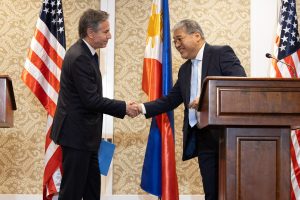U.S. Secretary of State Antony Blinken will tomorrow embark on a six-nation tour of Asia that will include visits to four Southeast Asian nations, beginning with a stop in Vietnam to attend the funeral of the late communist leader Nguyen Phu Trong.
In a statement yesterday, the State Department said that the tour will take Blinken to Vietnam, Laos, Japan, the Philippines, Singapore, and Mongolia between July 24 and August 3. The trip is intended to “reaffirm the importance of the work the United States does with our allies and partners in the Indo-Pacific to advancing security and prosperity and facilitating a shared vision for a free and open region,” the statement added.
The visit will begin in Vietnam, where Blinken will make the important gesture of attending the state funeral of Trong. He died on July 19, at the age of 80, after 13 years as the general secretary of the Communist Party of Vietnam. The funeral will take place in Hanoi on July 25 and July 26, during which a period of national mourning will be observed, the Vietnamese government said in a statement on Saturday. During the mourning period flags at offices and other public places will fly at half-mast and public entertainment will be prohibited.
Blinken’s attendance at the upcoming funeral is of considerable symbolic importance, and speaks to the recent advances in U.S.-Vietnam relations. In September, U.S. President Joe Biden traveled to Hanoi and announced a major upgrade in their bilateral relations. This capped off two decades in which the two former foes have seen a gradual convergence, based on parallel (though not fully congruent) concerns about China – in particular, its assertive actions in the South China Sea.
While in Vietnam, Blinken will also “further underscore the strength of the Comprehensive Strategic Partnership with his government counterparts in Hanoi,” the State Department said in a statement.
Blinken will then fly on to neighboring Laos, where in addition to a range of bilateral meetings, he will attended several meetings coinciding with the 57th ASEAN Foreign Ministers’ Meeting. During these various ministerial meetings, he will “discuss economic cooperation, the global fight against climate change, the ongoing crisis in Burma [Myanmar], the importance of adherence to international law in the South China Sea, and Russia’s illegal war against Ukraine.”
After a stop in Japan, Blinken and U.S. Secretary of Defense Lloyd Austin will meet with their Philippine counterparts Enrique Manalo and Gilberto Teodoro for a 2+2 Ministerial Dialogue – less than three weeks after holding a similar 2+2 meeting with Japan. Blinken and Austin “will also meet with Philippine President Ferdinand Marcos, Jr., to explore additional ways to capitalize on the unprecedented momentum in the United States-Philippines alliance.”
These talks will take place against a backdrop of tension in the South China Sea, where China and the Philippines have repeatedly engaged in confrontations at Second Thomas Shoal, a Philippine-occupied feature in the Spratly Islands. This has already led to a rapid strengthening of security cooperation between Manila and Washington, which included the expansion of U.S. access to Philippine military facilities and the U.S. military’s participation in joint patrols of the South China Sea. Blinken was last in the Philippines in March, when he affirmed Washington’s “ironclad” support for Manila in the South China Sea.
Blinken will then visit Singapore for meetings with Prime Minister Lawrence Wong, Senior Minister Lee Hsien Loong, and Foreign Minister Vivian Balakrishnan. Together they will “review the growth of our bilateral cooperation with this pivotal regional partner on shared security, economic, climate, and technology objectives,” the State Department said. Blinken will then conclude the whirlwind tour in Mongolia.
In addition to getting Blinken out of the political hothouse of Washington, D.C., which has been consumed by the drama over Biden’s decision last week to exit the presidential election in favor of Vice President Kamala Harris, the visit is another sign of the emphasis that the Biden administration has placed on diplomatic engagement with Southeast Asia, and the Philippines and Vietnam in particular, over the past three-and-a-half years. At the same time, the U.S. has drawn criticism for the shortfall between its rhetoric of commitment to the region and the reality, and its tendency to view the region as a subsidiary to its China policy.
Coming against the backdrop of the ongoing political turmoil in the U.S., the trip has the cast of a valedictory sojourn – one that inevitably raises questions of how the next U.S. administration will approach Southeast Asia.

































